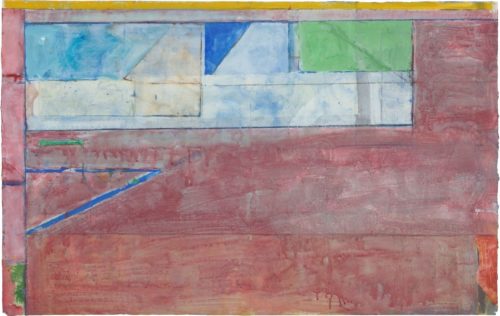
Richard Diebenkorn
“…many of the architectural projects of the past 20 years, celebrated by the international architectural press, express both narcissism and nihilism. The hegemonic eye seeks domination over all fields of cultural production, and it seems to weaken our capacity for empathy,compassion and participation with the world.”
Juhani Paalasma (The Eyes of the Skin; Architecture and the Senses)
“Of course the Ocean Park paintings have beauty and balance as their uppermost characteristics. The California blues are all there – cobalt, aqua, sky, cerulean, the faded jade and turquoise of boatyards, beaches and outdoor pools. And the architectural structure below is so elegant in its measured thinking, in its geometry and even its joinery.”
Laura Cumming (Guardian – review of Diebenkorn at Royal Academy, 2015)
“A few exceptions aside, superhero stories are about extremely rich white men making sure that the status quo remains unchanged, even in the face of apocalyptic outside threats. They can have supernatural powers or build amazing suits. But, they are first and foremost staunch and devoted capitalists to whom we should entrust our sense of security. The fact that so many of them are owners of private companies, which are celebrated as being sources of good and natural common wealth, is extremely problematic.”
Dan Hassler Forest (Interview, University of Amsterdam)

Ocean Park Public Library, Santa Monica, CA.
I have a great fondness for Richard Diebenkorn’s work. He was perhaps the first painter that I actually took a personal interest in when I was still a teenager. And it *was* personal, as I had lived for a time only blocks from Ocean Park in Santa Monica. Diebenkorn was unpretentious, a man married to the same woman for forty some years, and who migrated from New Mexico to Southern California, and to Berkeley. He felt like a local in my mind, and in a way he was. The colors were the colors of my youth. The distilled blueprints of southern California life, aqua and faded reds and greens. And Diebenkorn’s work had integrity. Never mind he came to be associated with (as Cumming put it) with down market decor. To see the work today, in person, is for most everyone I am sure, a surprise. First the canvases are big (he also painted a number of miniatures, but those were outliers) and they feel both spontaneous and discipled both. The influences are all there; from Hopper to Ab Ex to Georgia O Keefe and cross fertilized with Ralston Crawford, and even Charles Sheeler. And Matisse. And the work feels languid, and somehow those blues evoke the summer skies — not just of So Cal, but all big sky country. Diebenkorn was in Illinois for a time, too, and that midwestern plains sensibility is indelible. Few American painters were not touched by the great plains and the open skies of the mid west.
“Having seen many of these paintings in person, it is hard to convey the lyric majesty and open joyfulness they emanate . They exude such a pervasive feeling of light, horizon, water, beach, trees, space, the very feel of the air on your skin. It is hard to express or understate the evocativeness of these paintings. Also, they are just totally gorgeous.”
David Leeds (A Husk of Meaning)

Diebenkorn show, Museum of Modern Art, Ft Worth, 1969.
I wanted to start with Diebenkorn partly because of an idea of place and memory. My father’s side of the family moved to LA in 1905 I think. My grandfather, whose name was also John Steppling, was a silent film actor. My father spent his summers in Venice working at his uncle’s bakery. This is the early 1920s. Maybe earlier even. I grew up in Hollywood in the fifties and then sixties. But so much of my life was spent down at the beach in Santa Monica and Venice. This is long before it was gentrified and when, in fact, it was a very low rent area. And when I see Diebenkorn, I can feel that area of Ocean Park, near Joslyn Park, off Ocean Park Blvd. Drving up Strand or Ozone or 4th Streets, and yet, now, really, nothing of that remains. Ocean Park is actually an official ‘historic district’ today, and more or less those turn of the century clapboard bungalows are protected. But while many buildings are the same, the last time I was there I didn’t even recognize those familiar streets. In fact I didn’t even recognize the light anymore. Even the sky felt diluted. The gentrification is startling, and I honestly don’t know how or why anyone would want to live there now.
The photo below is a favorite of mine. Its Santa Monica Blvd, but where exactly I’m not sure. Probably its a bit further from the beach. It’s the early 50s. This is how I remember all of Los Angeles, actually. Shirtless, a guy sitting on bus bench NOT waiting for a bus. Not doing anything, really. Enjoying the sun. It is a small city still, in the 50s. It is slow and lazy, notwithstanding the post war enthusiasm for an imagined future. But in the beach towns along Pacific Coast Highway, nothing was ever urgent.

Santa Monica, early 1950s
This is a, perhaps, awkward segue into a discussion of a certain trend in contemporary consciousness, but because I am from El Lay, I have seen the changes in the landscape and the way they mirror the changes in both the American psyche, and in the political. And while the Santa Monica and Venice of Diebenkorn, and earlier of Raymond Chandler and Fante and Nathanial West, is long gone now, the residue remains. Or rather a dream remains, the outlines of a dream, an ever more distant memory of something that was lost. And that quality was already lost by the end of the 1960s. And certainly by 1980. For the 80s are the real watershed, the final historical demarkation for the paradise of Southern California as it must have existed throughout the early 20th century. Oddly perhaps, the best sense of mid century California beach life is some of Don Winslow’s pulp writing. Dawn Patrol for one. Kemm Nunn, too, a rather underrated writer, in Tapping the Source.
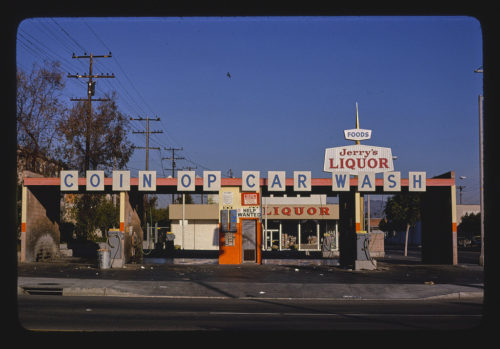
Main St. and Ocean Park, 1976.
Mike Davis, like me, is from Southern California.
“Compared to other great cities, Los Angeles may be planned or designed in a very fragmentary sense (primarily at the level of its infrastructure) but it is infinitely envisioned.”
Mike Davis (City of Quartz)
El Lay as the envisioned city. The labor history of California is well documented (Davis himself has written a good deal on it) and so I was looking to somehow describe more personally the sense I have of my home city. As I noted, my family, on both sides really, have been in southern California for a long while. My mom was Miss Michigan 1933, though she was disqualified for being secretly married (to a gangster out of the Purple Gang). But not before she got a trip to Los Angeles and a shot at modelling. She was a natural red head. A deep auburn red and that was always her nickname with her family, *Red*. The point though is LA grew very fast from the 60s on. My memories of the small lazy city of my youth soon became just that. And now when I visit I am acutely aware of the strange effects of Hollywood, of the industry. It permeates the city. I mean literally you cannot find anyone who is not within that 6 degrees of the entertainment business.

Orinda Theatre, San Francisco. Design Anthony B. Heinsbergan, opened 1941 w/ Maltese Falcon.
“This is a landscape of desire.… More than in almost any other major population concentration, people came to [Southern California] to consume the environment rather than to produce from it.”
Homer Aschmann (1959, Ecology of Fear, Mike Davis)
The sense I have now of Los Angeles was foreshadowed during my teenage years. This was a city unprepared to become a big city. The destruction of unions and the huge agricultural industry of the central valley, and its attendant armies of migrant workers, cast a long shadow. But this was a highly segregated city in my youth. And a deeply racist one. The westward migration after WW2 brought a white population that sought nothing of a cultural nature. Aschmann is right, it is a landscape of desire. It is and was a city fueled by a kind of ersatz erotica. Its hardly an accident that the San Fernando Valley become the porn film center of the world. That was a big part of entertainment and there has always been a ready supply of actors who need a paycheck, any kind of paycheck.
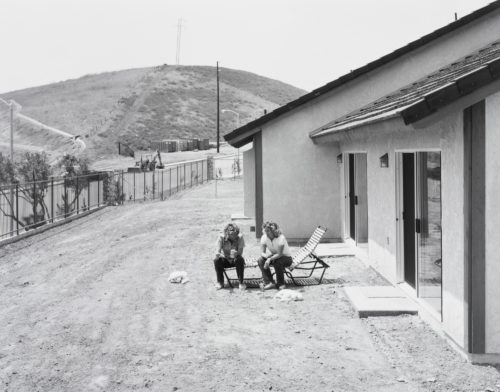
Joe Deal, photography. (Yorba Linda, CA 1984).
One of the few writers to really understand the left coast is Joan Didion. In her early essay Dreamers of the Golden Dream she outlines the real El Lay — that which is east of downtown, essentially. The San Bernandino badlands. Mike Davis is from Fontana, also on the I-10 that heads in a straight merciless concrete line from the ocean to the Mojave. San Berdoo is where the Hell’s Angels started.
“…the San Bernardino Valley would draw a kind of people who imagined they might live among the talismanic fruit and prosper in the dry air, people who brought with them Midwestern ways of building and cooking and praying and who tried to graft those ways upon the land. The graft took in curious ways. This is the California where it is possible to live and die without ever eating an artichoke, without ever meeting a Catholic or a Jew. This is the California where it is easy to Dial-A-Devotion, but hard to buy a book. ”
Joan Didion (Slouching Towards Bethlehem)
It was the western end of early Mormom settlements, and a place the Mormons chose to abandon. One in thirty eight people live in a trailer. Over the last fifteen or twenty years inner city blacks have migrated out to Berdoo. It has the highest crime rate and most corrupt and brutal police departments in the state. All the way up to Palmdale is still white, though. Well, save for a few latino outposts like Indio (mean average summmer temperature is around 100 f). This is both an astoundingly beautiful desert landscape, and also a hideous blighted destroyed landscape. William Vollman’s Imperial — about the southern most county in California is a useful guide to the general inland empire. When I was a boy it was date farms. As far as you could see. I remember driving with my father to get dates (and a date shake). We stopped at an old stand in Indio where an old white haired man sat smoking filterless Chesterfields and claimed to have met Wyatt Earp before he died (Earp lived out there for some of his final years). But in a sense this is the area that has shaped my aesthetic. Shaped my sense of America, probably, too. For this is the land of pessimism

Ron Davis
“Voting creates the illusion of legitimacy—that the system is responsive to the popular will, when, in reality, it resists it—while liberalism checks the popular will so that establishment interests remain ascendant in the face of the latent threat of the majority to elite interests.”
Steven Gowans (When liberal Democracy means Plutocracy)
Something of the quality of despair that hangs over San Bernadino and Riverside counties made its inexorable way into Hollywood. Something of that cracker conservatism (Nixon is from Whittier, in another corner of LA County, but Whittier is not unrelated culturally) seeped into film and TV product. The back lots of studios are manned by these people, white people, the descendants of post war migrations.
We had neighbors, when I was a boy, living in the flatlands of Hollywood, neighbors from Iowa, from Indianapolis, from Rhode Island. The Iowans were country people and their grown son Art, (funny I remember his name) lived in a small trailer out back. He was something like 6 7″ or so, taciturn and stooped. But one day he was gone. The next day the trailer was gone. That was just how things went. The sense of impermanence was quietly understood. The price for landscapes of desire is their impermanence. Nobody, as far as I know, asked after Art or the trailer.
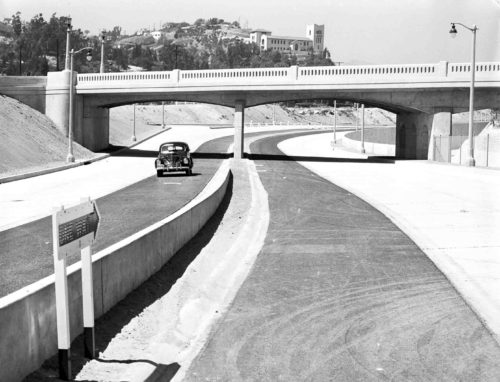
Arroyo Seco Freeway day after completion. 1940 (still used, as Pasadena Fwy).
“September 2017. Emmanuel Macron condemns the “laziness” of those in France who, according to him, are blocking his reforms. You’ve always known that this word is reserved for people like you, people who can’t work because they live too far from large towns, who can’t find work because they were driven out of the educational system too soon, without a diploma, who can’t work anymore because life in the factory has mangled their back. We don’t use the word lazy to describe a boss who sits in an office all day ordering other people around. We’d never say that. When I was little, you were always saying, obsessively, I’m not lazy, because you knew this insult hung over you, like a specter you wished to exorcize.
There is no pride without shame: you were proud of not being lazy because you were ashamed to be one of those to whom that word could be applied. For you the word lazy is a threat, a humiliation. This kind of humiliation by the ruling class breaks your back again.”
Edouard Louis (NYRB 2019)
Now, this is important in a sense — Louis in another interview noted that the bodies and faces he sees in the gilets jaunice movement are not the bodies or faces he is used to seeing in media. And this is something Pasolini noted again and again over fifty years ago. The Hollywood machine that managed to absorb a lot of the exhausted imaginations of those westward migrants also never lost the sense of social exclusion that today is more acute than ever. The city of LA, like the country of America, is ‘envisioned’. It is a network of exclusions, a latticework class hierarchy, within another class hierarchy, that is fitted over everything. But all of it is adjusted in these nearly infinite revisionist moments. And all to turn out a glossy advert for the ruling class. But nothing is ever watertight in the imagination. And those exhausted and pessimistic crackers from Riverside or San Bernandino who carried cable and worked as stunt men or grips — and the women who toiled in kitchens, or the pretty ones who fucked their way up and then sideways (for their is a low ceiling on that strategy)…their fingerprints and breath and dirt were impossible to completely erase.
The anger of the flyover states is rooted in the quality of invisibility that most people feel. If you live in Des Moines or Starkville, Mississippi, you know you will not be represented on TV. The only time the underclass appears is in caricature. But the public has internalized these affronts. The exclusion is now a structural element of their psyche. And contemporary personalities are composite fragments of various exclusions.

Aaron Morse
Louis said something else important. When the protests of the gilets jaunice surfaced the press and the ownership class called them racist, climate deniers and homophobic — but the reality was that the overwhelming violence in France comes from the dominant ownership class, from Macron and his pals. And that was my sense growing up — the problematic encounters were always with white small business owners. With property owners. The aspirational class of the 1950s. It came from the racist LAPD, and it came from a massive growth index that brought with it a draconian system of prohibitions. Don’t park there, don’t go there, do sit there, don’t do much of anything, actually. I saw the first hand imprint of social control. Later when I got into the criminal justice system, I recognized it. I already knew it. Only now it was weaponized in a sense. It was now immanently lethal. As Louis added at the end, people want to find a way to say “I suffer”.
“In the erstwhile world capital of teenagers, where millions overseas still imagine Gidget at a late-night surf party, the beaches are now closed at dark, patrolled by helicopter gunships and police dune buggies.”
Mike Davis (City of Quartz)
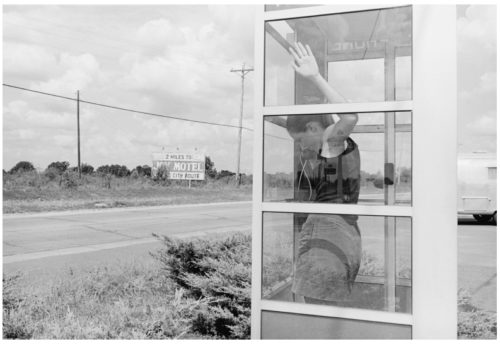
Henry Wessel, photography.
What one sees today in popular mythology, in Hollywood film and TV and in big electronic media operations is an open and constant drum beat of fascist nostalgia. And the road to this point has been a complexly structured affair. The pre conditions for such open fascist apologia did not just happen. It was, at least some of it, consciously manufactured. The rest of it has been a reflexive by product of a damaged collective, the gradual but inexorable momentum of marketing and kitsch and the simultaneous destruction of community and an elimination of the visibility of the working class. The last time anyone saw working class actors or heard working class writers, in large venues or on large platforms was probably almost forty years ago.
A brief digression as Albert Finney died this last week. Finney was born in the working class enclave of Salford in Manchester. He was one of the great actors that broke into prominence amidst the British New Wave. In his case in the excellent Saturday Night Sunday Morning. He was a kind of UK answer to John Garfield. Of all those who came up at that time…Tom Courtney, Richard Harris, Alan Bates et al….Finney was likely the greatest. Courtney a close second (and The Loneliness of the Long Distance Runner is my favorite film from that era of British film). Harris was always a bit too studied, too vain perhaps (though This Sporting Life is magnificent). Harris was sort of John Lee Hooker to Finney’s Muddy Waters (which makes Courtney Little Walter to push this metaphorical comparison). There were other terrific actors though, Laurence Harvey and Richard Burton of course, Rita Tushingham and directors like John Schlesinger, Byran Forbes, Jack Clayton, and Karel Reisz. Films such as these, and The L Shaped Room (with the incandescent Leslie Caron), and Look Back in Anger, The Entertainer, and Joseph Losey’s The Servant, with the Pinter screenplay were all of them class examinations. Nothing of the sort is being made today. End of digression.

Shirley Anne Field and Albert Finney (Saturday Night Sunday Morning)
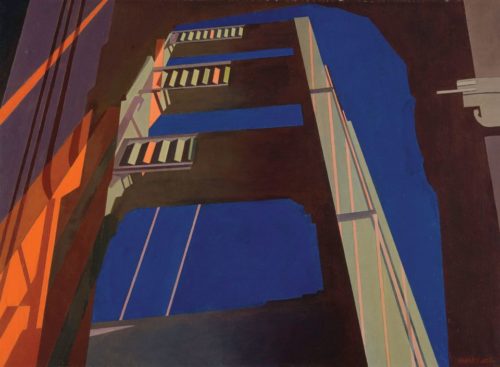
Charles Sheeler (Golden Gate Bridge, 1955).
There is a revealing essay at TLS this last month by Gavin Jacobson. It is titled “Our Age of Anxiety”. And one concludes thusly….
“But if, as the recent flurry of books have argued, democracy is facing its doomsday, it won’t do to presume that with a bit more emotional tinkering here and there we may return to some prelapsarian time before populism shook everything up. Rather, liberals must confront the tougher questions of why people should care about liberal democracy at all, why virtues such as love, and norms of civility and equality, are supposedly inviolable, and why, in the words of John Milton, we should prefer “Hard liberty before the easy yoke / Of servile pomp”.”
The message running beneath this is the need to get tough. All this wishy washy democracy and equality stuff. Its just servile pomp. What we need is *hard liberty*. Jacobson earlier quotes Frank Furedi, describing the current state of the West, with its absence of positive political ideals…ending with “a fear-based negative conception of authority”.
This is all obvious stuff in a sense. Reclaim the good side of authority, and with it a kind of masculine toughness. Admit its ok to be thrilled by Ian Paisley, or soon Adolf Hitler. Well, in fact….enter Jair Bolsonaro stage right.

Howardena Pindell
“Human rights are for the righteous”.
Gen. Augusto Heleno (Sec. of Institutional Security, Brazil)
If, as I contend, the erosion of a collective purpose, and an increasingly damaged psyche, and a ruling elite now entering a final phase of class domination, account for the misery and depression of the majority of people in the U.S., then it is interesting to view this from the perspective of Bolsonaro’s election. Perry Anderson has a pretty exhaustive piece at the London Review of Books right now. But Anderson’s conclusions are strangely blurry. For him Bolsonaro cannot be a fascist because there is no communist party to crush. No opposition at all, really. But that only makes Bolsonaro a 21 st century fascist ..or call him populist-authoritarian if you insist….who invents enemies of identity. Indigenous peoples, the poor, and sure, anything left wing. The identitarian fascist that is Bolsonaro is driven by the same kind of masculine terror that afflicts Liam Neeson.
The ruling class understood that the Bolshevik Revolution constituted a grave threat to their privilege and power. They began day one in the manufacturing of false narratives. The same with the Chinese Revolution. Except, of course, the Chinese were, well, Chinese. You couldn’t expect as much as you did from the blond Russians. Not to mention Cuba. No this was the primary goal of western capital. PRIMARY. Destroy the opposition. And that meant communism and socialism. The evolution of monopoly capitalism has meant the strange mediation of digital technology. I say strange because the effects, perhaps without all that much conscious intent, began to reshape how people behaved and certainly how they thought. One of the reasons that Freud and psychoanlysis (see comment in last blog post here) so threatens people is because if, if they grant him even a small authority or legitimacy, the implications in the digital age are far more disturbing than in analog times.

Frédéric Bruly Bouabré (Portraits of Dante and Stalin).
Gary Younge, writing of Neeson’s comments, remembers Buford Posey, who said in his later years…“Not until I got into the Army did I learn it was illegal to kill black people”. In the U.S. today the former blue collar work force is now mostly unemployed, or working service sector gigs, or part time work from home. They feel exhaustion of a sort only the beaten down underclass can experience. I remember as a boy tractors coming and pushing down our back fence. We had been issued an eviction notice but my parents hadn’t gotten it together to get out of there yet. The landlord wasn’t waiting. We had to hurry and shove things in boxes and just leave. I was pretty young…six maybe, or seven. But I saw the look in my father’s eyes. Nobody, in the U.S., will come help the underclass. They won’t do it. My father knew it. He recognized total defeat that day.
But back for a quick second to Freud and psychoanalysis. Today in the U.S., and maybe most of Europe to a lesser degree, society has surrendered to its own regression, to its infantility. And this accounts for the popularity (seemingly bottomless) for children’s stories, and children’s films and TV. Game of Thrones (which is not the book title) is a kid’s book. Harry Potter and Lord of the Rings….all are children’s stories. The TV output of Joss Whedon and JJ Abrams is essentially geared to teenagers.

Paul Delvaux
“Psychoanalysis is the continuous search for the hidden origin of “an old guilt”. This does justice to the major differences between Oedipus and Hamlet. In short, psychoanalysis is not about demonstrating the same complex over and over again, but about the recognition of constantly changing and shifting individual and even cultural issues.”
Herman Westerlink (A Dark Trace, Freud and the Sense of Guilt)
Childhood sexuality, and guilt, is a useful guide to the screen addicted adult children of the West. The narratives of , say, the last ten years, in mainstream product, reflect something both infantile (acutely so) and 19 century. Life is unfolding in children’s version of Dickens or Hardy.
“HBO must continuously promote discourses of ‘quality’ and ‘exclusivity’ as central to the subscription experience. These discourses aim to brand not only HBO, but its audience as well.”
Avi Santo ( It’s Not TV: Watching HBO in the Post-Television Era)
Now Game of Thrones is a particular good example of the neo colonial narrative that fuses Orientalist oppositions between a white West and the dark skinned slaves that Daenerys’s crusade is meant to liberate. All of them castrati, not uninterestingly. White saviours are still a TV staple in terms of plot points.
“The series’ racial politics in relation to its spatial organization is even more pronounced in the television adaptation, where the ‘Common Tongue’ in Westeros is English, while the inhabitants of Essos speak in made-up languages like ‘High Vallyrian,’ which are subtitled. The result is that the distinction between the ‘normal’ space of the kingdoms of Westeros, as a fantastical hybrid that fuses the British isles with continental Europe, systematically privileges the Eurocentric perspective over its available alternatives.”
Dan Hassler Forest (TV Series #6)
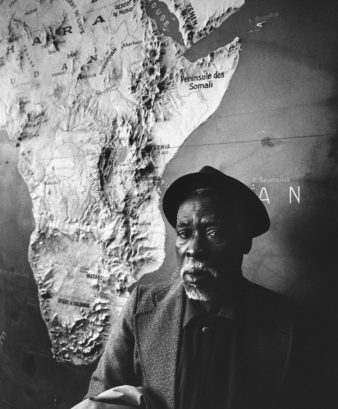
Frédéric Bruly Bouabré
There is an additional sub-text here, and that is infantilism. Despite or perhaps because of the huge amount of nudity and sex in the series, the branding is guaranteed an adult audience. But it is so much more complex than this. There is a strange dynamic at work between sex and authenticity. And whiteness, actually. The entire notion of authenticity, in terms of cultural styles and expression, came out of the 1960s and the white flight from the inner city. There are other aspects of this but I suspect this was a primary engine.
“The desire for an authentic urban experience began as a reaction to the urban crisis of the 1960s, when American cities were routinely described as hopeless victims of a fatal disease. They were losing their more affluent and ethnically whiter families to the suburbs. Public schools, parks, and streets were shoddy and uncontrollable. Elected officials worried about a growing budget gap between the services they were required to provide and the taxes they could collect from a poorer population, and a disastrous perception gap between the central city’s image of glamour and sophistication and neighborhoods that were being abandoned by landlords, residents, and businesses.”
Sharon Zurkin (Naked City)
The notion of authenticity is itself completely artificial. But as a tool of perception, and branding, is is enormously powerful. And there is a clear racist titillation attached to the idea of “authenticity”. Now Game of Thrones spliced 19th century novel storytelling to graphic displays of violence and attendant cynical responses, and much much nudity and at the end came out with ‘prestige TV fantasy’. Fan (kids) culture tends to be very prudish. The prestige TV audience is branded by its consumption of soft core porn. So this was both infantile and adult (novelistic narratives). Providing cynicism and graphic nudity in a show based on books from the fantasy genre, and framing it as a Dickens novel almost, gives you the biggest hit in cable TV history.

Katy Gambles, photography.
And the nudity is invariably softly lit, often candlelit, and more reminiscent of Playboy from the 70s than anything else. This was Dan Hassler Forest’s take, too, when he wrote ” While carefully working to remain inclusive towards the fan cultures that have traditionally sustained such texts, the HBO adaptation makes Martin’s story-world accessible to a ‘quality’ audience that does not define itself in terms of fandom. Instead, high-culture categories of authorship, novelistic narrative complexity, psychological realism, and adult-oriented scenes of sex and violence connect to a larger discourse of innovative quality television that is innovative and ‘edgy’ in ways that remain tasteful to bourgeois viewers.”
The search for authenticity then is intimately connected with brands. And this speaks to how deeply brands have infiltrated our psyches and character.
“The popular mode in the last few decades has been either to indulge in fantasies about inventing a history in which white people were the victims instead of the oppressors, as in a Tolkien-type narrative, or else one in which the only way forward is through intensified capitalism, as in the superhero genre. A dominant trend in the Hollywood movies of the 60s and 70s was a more critical position in terms of what American identity and responsibility in the world were. “
Dan Hassler Forest (Interview)
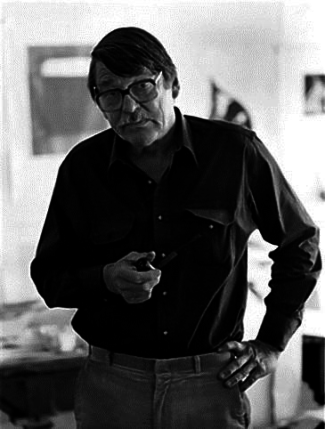
Richard Diebenkorn
Forest’s comment above reflects my feelings about culture and architecture and much else as it has changed over 40 years. Hollywood didnt make revolutionary films (well, not often) but it made films that had a genuine critical edge (I always think of Point Blank, John Boorman’s 1967 film). But I wrote about that film before..here…or Killer Of Sheep, which was made outside Hollywood, and Who’ll Stop the Rain or Nightmoves .
“As the Depression shattered broad strata of the dream-addicted Los Angeles middle classes, it also gathered together in Hollywood an extraordinary colony of hardboiled American novelists and anti-fascist European exiles. Together they radically reworked the metaphorical figure of the city, using the crisis of the middle class (rarely the workers or the poor) to expose how the dream had become nightmare. Although only a few works directly
attacked the studio system, noir everywhere insinuated contempt for a depraved business culture while it simultaneously searched for a critical mode of writing or filmmaking within it.”
Mike Davis (City of Quartz)
It is also worth asking about the capricious nature of timing. When The Wire appeared (2002) it happened at the perfect moment for its many failings to be overlooked. Not just overlooked but seen as their opposite. Why was it the perfect moment? Thats more difficult to say. It was clearly (and my own response was more ambivalent than later) somehow touching the 19th century novel storytelling framework — with binge watching (as its come to be called). This was the cusp of all that. That Simon has proved he cant write ANYTHING coherent since then only reinforces the idea that something in all of this mass cultural approval or rejection is trafficked in ways that remains far below the surface. Or its just accident. Certainly nothing that registers as a big “hit” can be seen to reproduce the writers that Davis listed above. The Sopranos (1999) started out as a comedy –watch the first few episodes. The title was a joke on castration . There is something in how the audience for TV is isolated. In the car generation the world has been remapped, emotionally and cognitively.
“Last November, they began to turn off their TVs, come out of their houses, join together at traffic circles and toll booths, get to know each other, grill sausages and feel empowered, rather than isolated and helpless. They thus humanized these “noplaces” or non-places created by the automobile civilization that had stripped their villages of post-offices, bakeries and cafés forcing them to spend two hours every workday in their cars.The Yellow vests represent a demographic cross section of France– naturally minus the top 2% or 3%. And, unfortunately, for the moment, minus the 10% (?) of France’s doubly oppressed, discriminated immigrant communities. The Arabs, Berbers, Black Africans and other immigrants who do most of the dirty jobs, who are rarely seen in civil service jobs, and whose youth riots in the Banlieues (Projects) seriously challenged President Sarkozy in 2005. (Partly due to my suggestion, the Montpellier Yellow Vests are starting to reach out to the immigrant communities.)”
Richard Greeman (Counterpunch 2019)
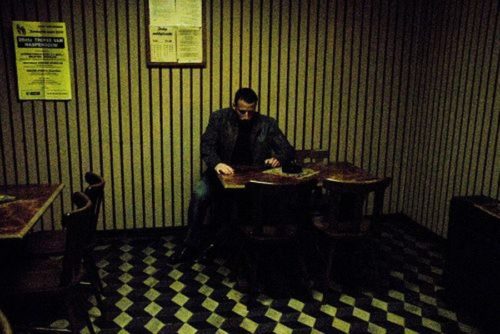
Bullhead (2011 Michaël R. Roskam dr.)
The point is that my home city, the LA where I grew up, attended Hollywood High, and later drifted to the streets…even in the 70s I could recognize something, however small, of life from that earlier time. It is today increasingly a land of no-places. So Cal may have invented the term no-place, in fact. There are artists who capture some of this, globally. Bruno Dumont’s Life of Jesus (1999) is a place to start. Bullhead (2011, Belgium. Michaël R. Roskam dr.) is another. Films of the forgotten.
Nobody walks in El Lay. Public transport is nearly non existent….at least when you realize over 20 million people live in the greater LA. For so long people, the public, accepted a kind of crude caricature that was all Palm Trees and beaches and hedonism. That is still the manufactured image for almost TV shows set in so Cal. I remember watching an episode of Ray Donovan and realizing that the time line was absurd in terms of travel and drive times etc. Not even the rich can get from there to here THAT fast. In fact LA — for all its preferable weather, is a broken dystopian mega city, a necropolis in fact. The capitalist core surrounded by something increasingly resembling Lagos or Jakarta.
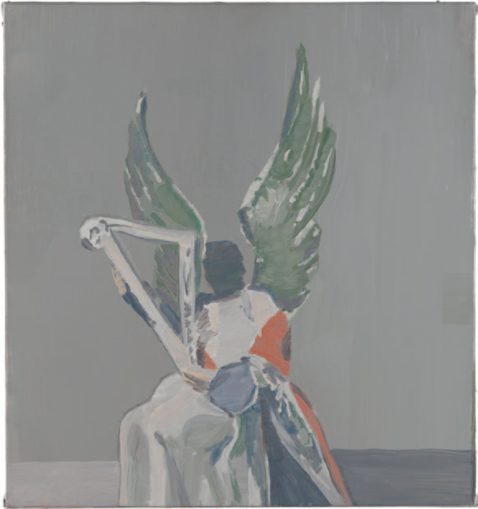
Luc Tuymans
Diebenkorn was, for me anyway, the artist from an El Lay that once existed. At least for a moment or two. When beach towns were cheap and run down and fun. And that is not a small thing.
Thanks to those who have donated. And TO donate, just use the paypal button at the top of the page. Thanks.

“So again the fascist rehabilitation is open. And again, there is a racist underpinning, as Paisley actively campaigned against the civil rights movement and organized gangs of club carrying thugs to block pro civil rights protestors. The inherent acceptability of fascism.”
Brings to mind AOC’s lauding of Buckley.
exactly
Thanks for sharing some of your personal history, John. I was just watching Criterion Streaming…Finney’s film in tribute I guess is. Great photos to go along with your article as well.
FYI ..the East Coast had its share of those funky old beach towns. I grew up in one in the 50’s. All gone now so that condominiums can house the upper middle class in overpriced ugliness. Same thing happening in No Cal near East Bay.
AOC and Buckley? Had no idea. I’m convinced someone is making her their talking hand puppet. For what ends I wonder? Such is the power of illusion. She almost fooled me with the latest viral video.
I find this one a very eloquent elegy for a lost time and place, possibilities, causes, sensitivities. Never been to L.A. but you capture it very well for those of us who never experienced it as it was and liked the digression.
You really wrote from experience here, John. It smells right, even. Alongside the valuable intellectual castles are shanties of grit,
John, you always have commies on your brain. Swing, baby
John, You always write about Los Angeles so well…like no one else really. I’d love (selfishly) to see you write a book — kind of a riff on Reyner Banham — along the lines of “Los Angeles: The Deconstruction of Four Ecologies” (yes, Deconstruction for Architecture is kind of obvious & heavy-handed but you get the idea)